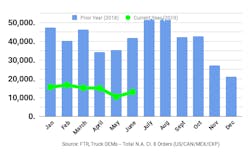North America Class 8 orders were up in June — compared to May’s three-year low — but significantly down compared to June of 2018, according to preliminary data from two research firms that track trucking industry sales. And with tariff uncertainty still rippling through the industry, OEMs are cautious about taking on new orders too far in advance.
The industry booked 13,100 units in June, according to ACT Research, which is a 20% increase from the previous month but down 69% from last June. FTR reports June Class 8 orders at 13,000 units, up 24% from FTR’s May numbers. Including June activity, this is the weakest 6-month start to a year since 2010, according to FTR.
Most orders for 2019 delivery have already been placed. Fleets are moving around previously placed orders and adjusting delivery times according to business conditions and smaller fleets and dealers are placing small fill-in orders, as production slots become available in the near term, according to FTR. Backlogs should fall under 200,000 units for the first time since May 2018. Class 8 orders for the past 12 months now total 331,000 units.
“The orders are truly a mixed bag,” said Don Ake, FTR vice president of commercial vehicles. “One OEM reportedly started to take orders for 2020, but the other OEMs apparently did not. Without the 2020 orders, the total would have dipped below the 10,000 unit mark. Most OEMs are reluctant to quote future trucks due to uncertainty over material costs. Until the tariff situation is resolved, it is risky to quote prices for 2020. Fleets are also reluctant to accept material surcharges with this much ambiguity present.”
The weak freight market and rate conditions across the continent coupled with a large Class 8 backlog “continue to bedevil new Class 8 orders,” said Kenny Vieth, ACT’s president and senior analyst. “Seasonal adjustment lifts June’s Class 8 net orders to 15,100 units, and through the first half of 2019, Class 8 net orders were booked at a 181,000 SAAR.”
While the economy and freight are still growing, Ake noted, the latest manufacturing data is not promising. “The consumer sector is sturdy, he said, “but freight growth is expected to moderate the rest of the year. As a result, Class 8 truck build rates should begin to decrease in the coming months.”
Medium-duty orders
Regarding the medium-duty market, ACT’s Vieth said that order trends remain off the pace set in the first half of 2018, but continue to benefit from the strength in the consumer economy.
In June, North American Classes 5-7 net orders were at 19,200 units, according to ACT preliminary data. That is down 30% year-over-year and 5.7% from May.
“While we have to go back 23 months to find a weaker MD order month on an actual basis, we only have to go back three months when looking at seasonally adjusted data,” Vieth added.
About the Author
Josh Fisher
Editor-in-Chief
Editor-in-Chief Josh Fisher has been with FleetOwner since 2017. He covers everything from modern fleet management to operational efficiency, artificial intelligence, autonomous trucking, alternative fuels and powertrains, regulations, and emerging transportation technology. Based in Maryland, he writes the Lane Shift Ahead column about the changing North American transportation landscape.


